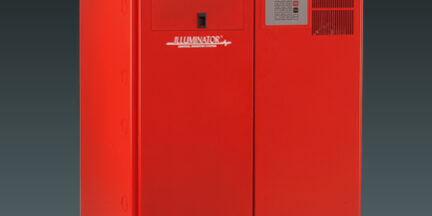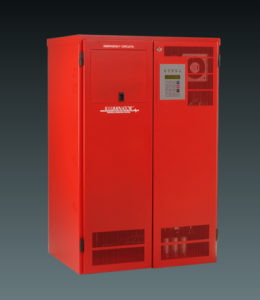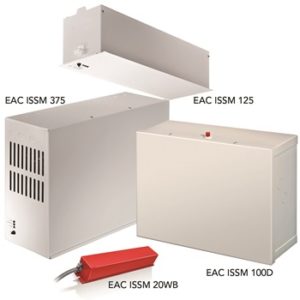1. Central Inverter Basics 2. Benefits of Inverters 3. Wiring Schematics and Load Calculations Explained 4. What are the Cost Savings? 5. Common Terms for Inverter Schematics 6. Inverter Manufacturers
Central Inverter Basics
Lighting Inverters ensure uninterrupted power to devices in times of power outages. They do this using a battery system that converts DC to AC voltage via electronic circuitry. During utility power, batteries are charged and during outages, batteries back up devices.Central inverters are located in one central location (hence the name) and can be designed to power any number of devices at full lumen capacity. Central inverters can also power fixtures in a dimmed state. For example, a room could have 10% of the fixtures powered at 100% output or 100% of the fixtures powered at 10% output. In addition, many modules can provide single, split, and three phase outputs eliminating costly, inefficient external transformers.Inverters are more compact, efficient and have more control and diagnostic features than ever. These features allow for greater reliability in times of power outages and greater convenience during testing.What are the Benefits of Inverters Over Emergency Battery Packs?
Lumen output and maintenance/testing are the two major benefits of installing an central inverter system. The lumen output of fixtures powered by an emergency battery pack is roughly 30-40%. Diminished performance requires additional battery packs be added to meet required lighting levels.Lights powered by inverters can perform at 100% lumen output. The photo below shows two lit fixtures; the bright light on the right is lit by an Evenlite Inverter designed to provide 100% lighting output. The dim light on the left is powered via battery pack.[caption id="attachment_920" align="aligncenter" width="1024"]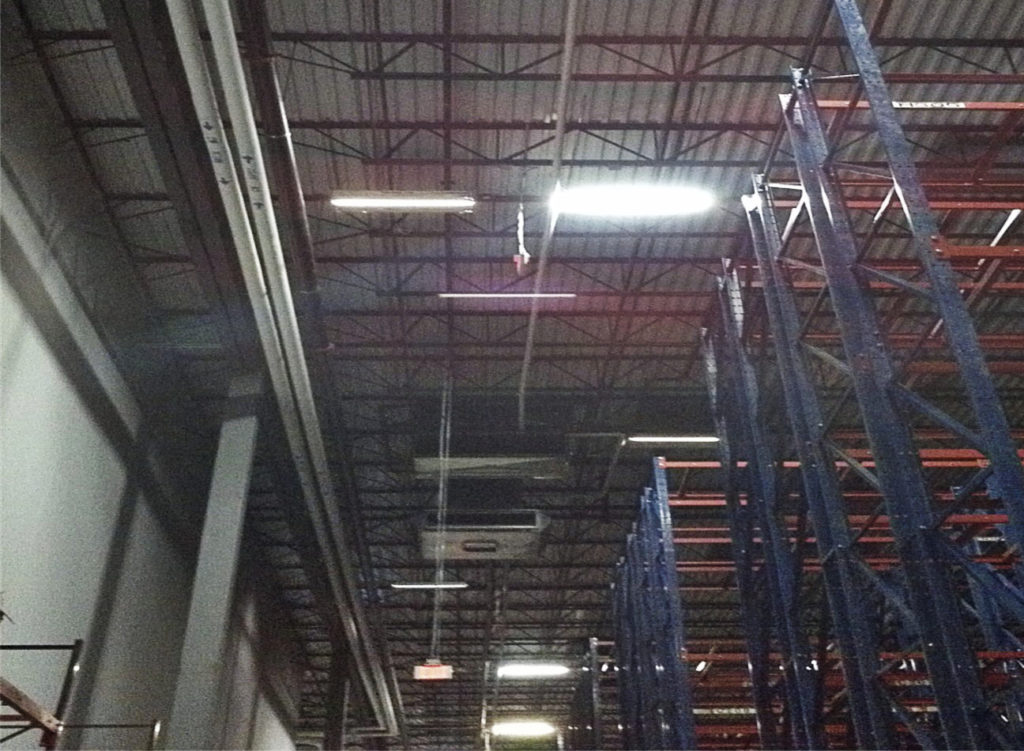 Light on right powered by Evenlite Inverter. Light on left powered by EMP[/caption] When it comes to required monthly and annual emergency light testing, inverters have the maintenance advantage. Today’s fixture types are generally modern and thin. This makes it difficult to install a battery pack directly into the fixture so many EMPs are typically placed in the ceiling grid above the fixture.Imagine physically testing each individual battery pack and cataloging the results; it’s a job! By contrast, the centralized location of an inverter allows for easy, accessible testing and results retrieval in a single location.To make monitoring and testing even easier, many inverters have a wide range of diagnostic features. For example, Evenlite’s LiteMinder offers a unique web interface that constantly monitors the system status and records all essential data. Users log on, view, interact and download records as needed. They can also monitor, remote diagnose and install software upgrades.
Light on right powered by Evenlite Inverter. Light on left powered by EMP[/caption] When it comes to required monthly and annual emergency light testing, inverters have the maintenance advantage. Today’s fixture types are generally modern and thin. This makes it difficult to install a battery pack directly into the fixture so many EMPs are typically placed in the ceiling grid above the fixture.Imagine physically testing each individual battery pack and cataloging the results; it’s a job! By contrast, the centralized location of an inverter allows for easy, accessible testing and results retrieval in a single location.To make monitoring and testing even easier, many inverters have a wide range of diagnostic features. For example, Evenlite’s LiteMinder offers a unique web interface that constantly monitors the system status and records all essential data. Users log on, view, interact and download records as needed. They can also monitor, remote diagnose and install software upgrades.How are Loads Calculated & Wiring Schematics Determined?
In speaking with local engineers who specify inverters, there are 2 primary considerations in planning for an inverter:1. Calculating Load: Calculating load is relatively straight forward. Inverter power is rated in VA or KVA.
Some inverters are rated to operate at full load. However, manufacturers will recommend de-rating by 15% (for example) to determine the size of the inverter you need for your project and to account for unknown conditions that might exceed the unit rating. Check with your manufacturer for de-rating recommendations.
What types of inverters and brands can Resource Lighting + Controls help with? We can supply inverter systems with voltage ratings from 120vac to 480vac and power ratings from 100VA to 50kVA from major manufacturers:
Bodine Evenlite Myers Emergency Power Systems Power Sentry Safety
2. Determining Wiring Schematics: Determining correct wiring is also relatively straight forward, but admittedly takes a little time. Here’s what you need to know: wiring schematics are easily accessible from most manufacturers. Below is a wiring typical example for the LiteMinder Inverter by Evenlite. If you need wiring typicals and don’t readily see them on the manufacturers website, contact us and we’ll get the schematics for you. See a list of important inverter wiring terms at the bottom of this article.
For complex jobs, a second look at your schematic may be what you need or you may need assistance developing the schematic. Resource Lighting + Controls specializes in offering exceptional customer service and this includes involving manufacturers in providing wiring diagrams to help you ensure you’ve created the most efficient plan. For complex systems, Resource Lighting + Controls offers a project manager to facilitate factory start-ups and a pre-construction meeting to assist contractors with installation questions. Contact us about our value add services.
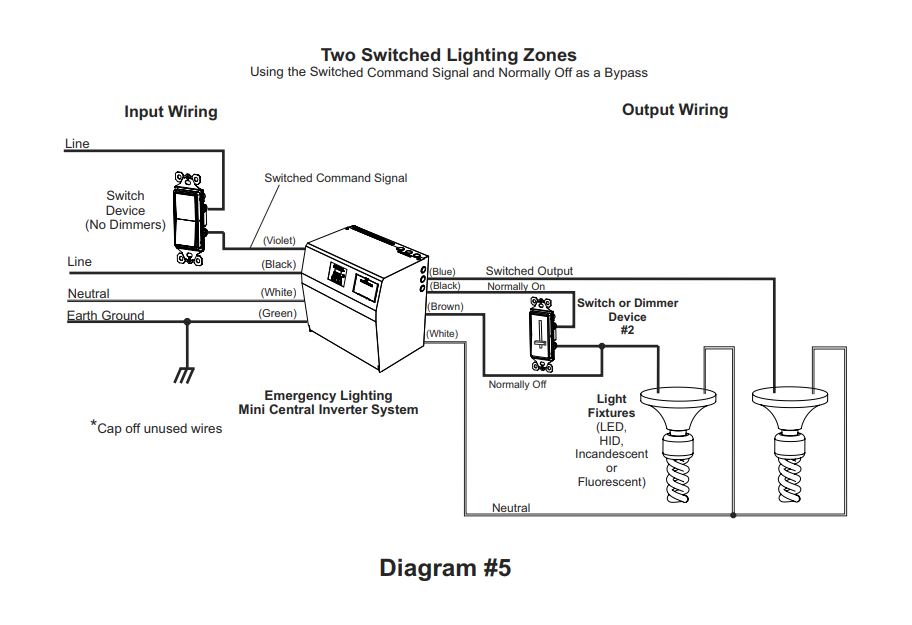 LiteMinder Modular Inverter SeriesThe LiteMinder (325w and 525w units) Central Inverter System is a sophisticated, versatile and cost-effective unit designed to give users unparalleled ease-of-use, with powerful functionality previously reserved for much larger systems. The included UL 924 approved Self-Test/Self-diagnostics features a scrolling LCD display that provides eight points of critical system status events.
LiteMinder Modular Inverter SeriesThe LiteMinder (325w and 525w units) Central Inverter System is a sophisticated, versatile and cost-effective unit designed to give users unparalleled ease-of-use, with powerful functionality previously reserved for much larger systems. The included UL 924 approved Self-Test/Self-diagnostics features a scrolling LCD display that provides eight points of critical system status events.1. Advanced startup diagnostics: protects unit at initial startup by performing several checks for common installation errors. 2. Pure Sine Wave output-compatible with all lighting loads 3. Very High (4x overload rating) ensures that even the most demanding loads will start up 4. Self-Diagnostics that retain critical data logs, saving you time and money 5. No factory start up required
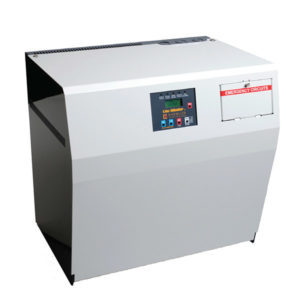
1. Three Phase, Pure Sine Wave 2. 120V/208V or 277V/480V 3. UL 924 Self-Testing and Diagnostics via Front Meter Panel 4. Internal Maintenance Bypass Switch 5. Front Access, Maintenance-Free VRLA batteries 6. Supports All Lamp Sources 7. Many Optional Features: Output Circuit Breakers (10-63A), Output Trip Alarm, 20 Year Battery Warranty (1 Year Full, 19 Pro-rated), Alternate Cabinet Configurations
1. Capacities range from 20W – 375W and dimming functionality (EAC ISSM 100D only) for a variety of applications 2. Operate the connected load at higher light levels than emergency drivers to ensure Life Safety code compliant light levels at higher mounting heights 3. UL listed, CSA approved, NFPA101 (Life Safety Code) compliant
Are Inverters More Cost Effective than Emergency Battery Packs?
It’s easy to see that there’s a cost savings in maintenance and performance, but every specifier is trying to hit budgets. Often times, the initial cost of an inverter is comparable to individual battery packs or even less expensive. Every project is unique. If you’re a local Hampton Roads specifier needing an ROI on your specific project, contact us.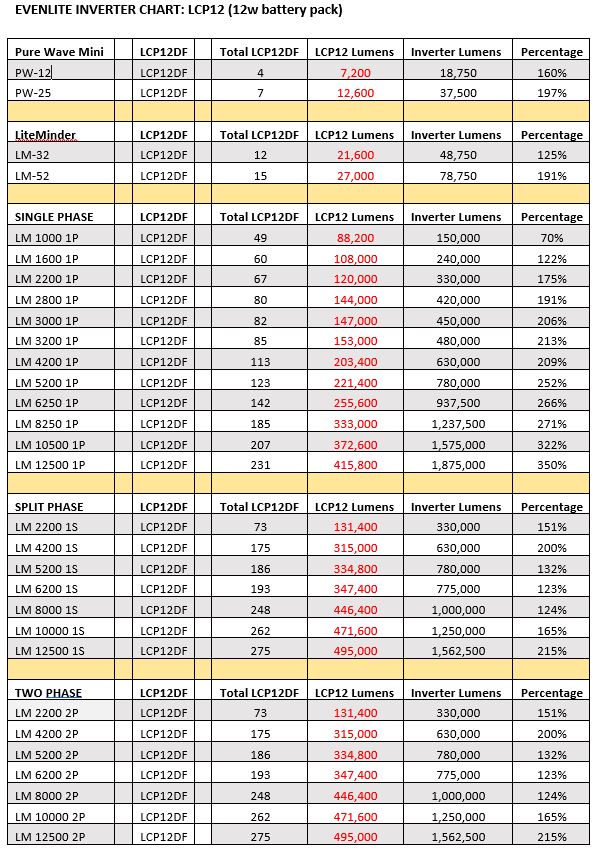 However, here’s some tangible information to answer the question of cost. You can calculate how many EMPs are required to achieve identical lumen output for various Evenlite inverters…don’t worry, we’ve done this for you for each Evenlite inverter. Then, simply ask a Resource Lighting Consultant for a budgetary quote on the inverter vs. the number of batteries required. The data is based on LCP12 (12w batter packs) with an average of 150 lumens per watt.
However, here’s some tangible information to answer the question of cost. You can calculate how many EMPs are required to achieve identical lumen output for various Evenlite inverters…don’t worry, we’ve done this for you for each Evenlite inverter. Then, simply ask a Resource Lighting Consultant for a budgetary quote on the inverter vs. the number of batteries required. The data is based on LCP12 (12w batter packs) with an average of 150 lumens per watt.INVERTER SCHEMATICS TERMS
Switched Command Signal: The Switched Command Signal instructs the Switched Output to turn on or off during normal operation. The Switched Command Signal does not carry current and does not feed the load. When the Switched Command Signal is on, the lighting load (connected to the Switched Output) is fed from the Line through an internal relay- the Switched Command Signal controls this relay.
Switched Device: This device provides either a signal to the Switched Command Signal or carries current to the lighting load from one of the outputs. Typical devices are Wall Switches, Time Clocks, Photo Cell Controls, Motion Sensors, etc.
Switched Lighting Zones: A zone is a circuit load that is being switched or dimmed for normal lighting use. The maximum number of zones (switched loads) that can be configured is TWO only, see diagrams 5 & 6. If more zones are required, an optional EPC series Remote Transfer Device can be purchased per zone.
Normally Off Bypass: Allows the lighting load to be switched or dimmed during normal lighting use. In the event of a power failure (loss of un-switched line) the load is fed from the inverter at full rated line voltage, providing full brightness in the emergency mode.
Normally Off Output: When connected directly to the lighting load (without switch or dimming device) assumes the load to be always off. In the event of a power failure (loss of un-switched line) the load is fed from the inverter at full rated line voltage, providing full brightness in the emergency mode.
Normally On Output: When connected directly to the lighting load (without switch or dimming device) assumes the load to be always on (i.e. Exit Signs, Security Lighting). In the event of a power failure (loss of unswitched line) the load is continued to be fed from the inverter at full rated line voltage.
[dt_button link="https://www.evenlite.com/" target_blank="true" button_alignment="center" animation="fadeIn" size="medium" style="default" bg_color_style="default" bg_hover_color_style="default" text_color_style="default" text_hover_color_style="default" icon="fa fa-chevron-circle-right" icon_align="right"]Learn More[/dt_button]]]>
